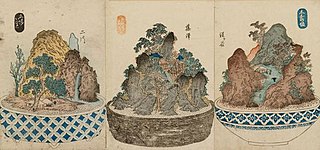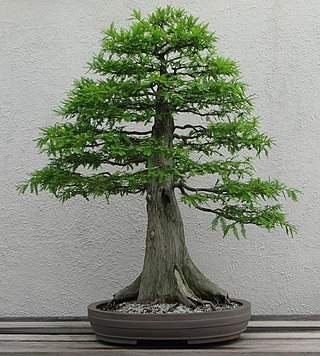
Shinji Suzuki (born 1954) is a Japanese bonsai artist and master known for his traditional yet innovative approach to bonsai cultivation.

Shinji Suzuki (born 1954) is a Japanese bonsai artist and master known for his traditional yet innovative approach to bonsai cultivation.
Shinji Suzuki was born in 1954 in Japan. His journey in bonsai began in his youth, inspired by the serene beauty of nature and the cultural tradition of bonsai in Japan. His skills were honed through a rigorous apprenticeship under the legendary bonsai master Masahiko Kimura. This period was formative in Suzuki's career, allowing him to absorb traditional bonsai techniques while also developing his unique artistic vision, characterized by an emphasis on simplicity, balance, and a deep connection to natural forms. [1] [2]
Suzuki's bonsai philosophy centers on working harmoniously with each tree's natural form. He believes that bonsai artists should respect the inherent beauty of the tree rather than impose rigid, artificial forms. Suzuki's creations often emphasize natural branching and trunk lines, and he prioritizes allowing each tree to develop in a way that mirrors its growth in the wild. This philosophy reflects aspects of Zen and Taoist principles, particularly the idea of harmony with nature, a core tenet in traditional Japanese aesthetics. [1]
Shinji Suzuki's works are featured in many bonsai exhibitions in Japan and around the world. His garden in Obuse, Nagano, is home to a significant collection of bonsai masterpieces, including ancient trees dating back to the Tokugawa period. This space is notable for its meticulous arrangement, which demonstrates Suzuki's attention to detail not only in bonsai but also in the surrounding environment. The order and cleanliness of his garden are seen as an extension of his artistry, creating a setting that enhances the bonsai viewing experience. [2]
Suzuki is also a teacher who has trained several apprentices from Japan and abroad, passing down traditional bonsai techniques while encouraging individual expression in the art form. His teachings emphasize patience, observation, and an understanding of each tree's unique potential, guiding students to foster a deeper appreciation for bonsai as a living art. Through his students and workshops, Suzuki has inspired a new generation of bonsai artists and contributed significantly to the international spread and appreciation of Japanese bonsai culture. [1]

In traditional Japanese aesthetics, wabi-sabi (侘び寂び) is a world view centered on the acceptance of transience and imperfection. The aesthetic is sometimes described as one of appreciating beauty that is "imperfect, impermanent, and incomplete" in nature. It is prevalent in many forms of Japanese art.

Bonsai is the Japanese art of growing and shaping miniature trees in containers, with a long documented history of influences and native Japanese development over a thousand years, and with unique aesthetics, cultural history, and terminology derived from its evolution in Japan. Similar arts exist in other cultures, including Korea's bunjae, the Chinese art of penjing, and the miniature living landscapes of Vietnamese Hòn non bộ.

Japanese art consists of a wide range of art styles and media that includes ancient pottery, sculpture, ink painting and calligraphy on silk and paper, ukiyo-e paintings and woodblock prints, ceramics, origami, bonsai, and more recently manga and anime. It has a long history, ranging from the beginnings of human habitation in Japan, sometime in the 10th millennium BCE, to the present day.

Penjing, also known as penzai, is the ancient Chinese art of depicting artistically formed trees, other plants, and landscapes in miniature.

A bonkei is a temporary or permanent three-dimensional depiction of a landscape in miniature, portrayed using mainly dry materials like rock, papier-mâché or cement mixtures, and sand in a shallow tray. A bonkei contains no living material, in contrast with related Japanese art forms bonsai and saikei: bonsai contain living trees, and saikei contain living trees and other vegetation.

Japanese aesthetics comprise a set of ancient ideals that include wabi, sabi, and yūgen. These ideals, and others, underpin much of Japanese cultural and aesthetic norms on what is considered tasteful or beautiful. Thus, while seen as a philosophy in Western societies, the concept of aesthetics in Japan is seen as an integral part of daily life. Japanese aesthetics now encompass a variety of ideals; some of these are traditional while others are modern and sometimes influenced by other cultures.

John Yoshio Naka was an American horticulturist, teacher, author, and master bonsai cultivator.

Deadwood bonsai techniques are methods in the Japanese art of bonsai that create, shape, and preserve dead wood on a living bonsai tree. They enhance the illusion of age and the portrayal of austerity that mark a successful bonsai.

Saikei (栽景) literally translates as "planted landscape". Saikei is a descendant of the Japanese arts of bonsai, bonseki, and bonkei, and is related less directly to similar miniature-landscape arts like the Chinese penjing and the Vietnamese hòn non bộ. It is the art of creating tray landscapes that combine miniature living trees with soil, rocks, water, and related vegetation in a single tray or similar container. A saikei landscape will remind the viewer of a natural location through its overall topography, choice of ground materials, and the species used in its plantings.

Bonsai aesthetics are the aesthetic goals and characteristics of the Japanese tradition of the art of bonsai, the growing of a miniature tree in a container. Many Japanese cultural characteristics, particularly the influence of Zen Buddhism and the expression wabi-sabi inform the bonsai tradition in that culture. A lengthy catalog of conventional tree shapes and styles also helps provide cohesion to the Japanese styling tradition. A number of other cultures around the world have adopted the Japanese approach to bonsai, and while some variations have begun to appear, most hew closely to the rules and design philosophies of the Japanese tradition.

Goshin is a bonsai created by John Y. Naka. It is a forest planting of eleven Foemina junipers, the earliest of which Naka began training into bonsai in 1948. Naka donated it to the National Bonsai Foundation in 1984, to be displayed at the United States National Arboretum; it has been there ever since. The individual trees represent Naka's grandchildren.

Chrysanthemumbonsai is a Japanese art form using cultivation techniques to produce, in containers, chrysanthemum flowers that mimic the shape and scale of full size trees, called bonsai.
Living sculpture is any type of sculpture that is created with living, growing grasses, vines, plants or trees. It can be functional and/or ornamental. There are several different types of living sculpture techniques, including topiary, sod works, tree shaping and mowing and crop art. Most living sculpture technique requires horticultural skills, such as grafting or pruning, to create the art.

Bonsai cultivation and care involves the long-term cultivation of small trees in containers, called bonsai in the Japanese tradition of this art form. Similar practices exist in other Japanese art forms and in other cultures, including saikei (Japanese), penjing (Chinese), and hòn non bộ (Vietnamese). Trees are difficult to cultivate in containers, which restrict root growth, nutrition uptake, and resources for transpiration. In addition to the root constraints of containers, bonsai trunks, branches, and foliage are extensively shaped and manipulated to meet aesthetic goals. Specialized tools and techniques are used to protect the health and vigor of the subject tree. Over time, the artistic manipulation of small trees in containers has led to a number of cultivation and care approaches that successfully meet the practical and the artistic requirements of bonsai and similar traditions.

Bonsai is a Japanese art form using miniature trees grown in containers. Similar practices exist in other cultures, including the Chinese tradition of penjing from which the art originated, and the miniature living landscapes of Vietnamese hòn non bộ, but this article describes the Japanese tradition.
Yuji Yoshimura was a second-generation distinguished bonsai master who taught traditional Japanese techniques and aesthetics to enthusiasts in the West.
William N. Valavanis, is a Greek-American bonsai master who carries on Yuji Yoshimura's tradition of teaching Japanese techniques and aesthetics to enthusiasts in the West.

Bonsai is a Japanese art form using trees grown in containers. Similar practices exist in other cultures, including the Chinese tradition of penjing from which the art originated, and the miniature living landscapes of Vietnamese hòn non bộ. The term "bonsai" itself is a Japanese pronunciation of the earlier Chinese term penzai. The word bonsai is often used in English as an umbrella term for all miniature trees in containers or pots. This article focuses on the history of bonsai in Japan and, in modern times, worldwide.
Kunio Kobayashi is a Japanese bonsai artist, and the owner of the Shunkaen Bonsai Museum in Tokyo.

The Luis Vallejo Bonsai Museum is a public access museum located in Alcobendas, Madrid, Spain, dedicated to the display and study of the art of bonsai. The museum was opened in 1995 and is one of the most important in Europe in its class. The museum presents the personal collection of Luis Vallejo as well as specimens donated by others. The collection is widely considered one of the best outside Japan, with multiple trees having received important awards in Spanish and international competitions.